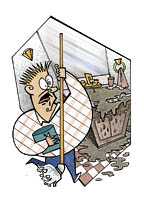
When the subject of backflow protection came up, I emphasized some of the recent changes in the code requirements. Of course, the spill-proof vacuum breaker was added as an acceptable backflow preventer. The beauty of this backflow preventer is that a valve can be located downstream of the vacuum breaker, and you can be assured that there will be no spitting action from the valve. Standard pressure vacuum breakers can spit or leak water when protecting against backflow.
Next, I mentioned how great it is that the new code clearly states that all new backflow preventers must be tested and certified prior to being placed in service. My joy, regarding this requirement, was met by dead stares. I quickly realized that the joy I felt was not being shared.
The first comment was, “Say what?” I again explained how nice the code is in requiring testing on every new installation. Then pointing out that not only is it clear in the International Plumbing Code, it reads almost identical in the Uniform Plumbing Code.
The next response was, “You’re kidding!”
Then the group really perked up with, “You know what that is going to cost me?” “Don’t we trust the manufacturer?” “Who’s going to maintain all the paperwork?” “Every time I install a boiler I need to do this testing?” “Are the inspectors going to enforce this?”
Boy, did I feel foolish. Here I thought everyone would agree that a backflow preventer is only as good as its last test. Hence, when a new one is installed, how do we know the backflow preventer is any good until we test it?
The plumbing codes are not kidding. Both the IPC and UPC have statements that read, “Reduced pressure principle backflow preventer assemblies, double check-valve assemblies, double-detector check- valve assemblies, and pressure vacuum breakers assemblies shall be tested at the time of installation, immediately after repairs or relocation and at least annually.” The codes both go on to reference ASSE 5010 for the testing and certifying procedures.
In many states this means that the testing must be done by a certified backflow tester. The certification is not difficult for any plumbing contractor to obtain. As for the paperwork, that varies from state to state.
For one hospital project, I asked the foreman of the construction site when all of the backflow preventers were last tested. The construction was a small addition to a large existing hospital complex. A week later, he thanked me profusely since it took three days to test all of the backflow preventers. As expected, about 10 percent of the backflow preventers needed repair.
As for the cost, I was surprised at the comment. The testing should never cost a contractor a dime. The cost is paid by the customer. Testing of the backflow preventer should be added into any bid for work involving such an installation. If you need to bring in an outside testing company, again, the customer has to pay for this.
How Soon?
The concern by a number of the contractors was how quickly the inspectors were going to pick up the new code requirement. They were in the middle of some projects that had backflow preventers. They did not want to bite the bullet to test and certify the backflow preventers. That is when creative extras need to be addressed. I suggested that they attempt to obtain an extra based on the fact that the code changed and a new requirement calls for the testing of the backflow preventer. That shouldn’t be a difficult extra to have approved.The other concern with the cost was based on the enforcement. As one contractor stated: “If I am good and add the testing to my bid and my competitor doesn’t, I may lose the job. If the inspector doesn’t enforce the requirement, then my competitor gets away, scott-free, with violating the code.”
I suggested a different tactic. Why not inform all of the inspectors of the new code requirement for testing and certifying backflow preventers? Then publicize the requirement to all of the contractors through the local contractors’ association newsletter. The result is everyone is on an equal footing.
As for trusting the manufacturers, it is not a matter of trust. The manufacturers of backflow preventers will be the first to tell the contractors that the valve must be tested prior to being placed in service. If they are not, then the manufacturers are not responsible if a valve fails.
From a contractor’s standpoint, this code requirement should be viewed as a liability concern. If you do not test a backflow preventer, and it fails, who is liable? Ask your corporate attorney, and I am sure they will say you are.
It you do test the valve, and maintain a record of that test, then you have no liability. We all know that a backflow preventer can fail. But assuming you conform to the code requirements for testing, then you performed your duty and are not liable. That is just smart business practice.
And yes, this would apply to every boiler installed in a residence. The boiler has a reduced pressure principle backflow preventer installed on the water supply. Hence, after installing the valve, a test is required, even in a single-family dwelling.
Some of you are probably saying, “Boy, it sounds like you were in a backwards state.” No, not really. It is still amazing how many states do not have strong backflow testing and certifying requirements. It is for that reason that the plumbing codes were modified. It used to be left to state backflow laws — now it is clearly spelled out in the plumbing code.
If you are not certified as a backflow preventer tester, look into it right away. Start testing all of the new installations. You can also start to offer your customers the annual testing and certifying of the valves as well.
